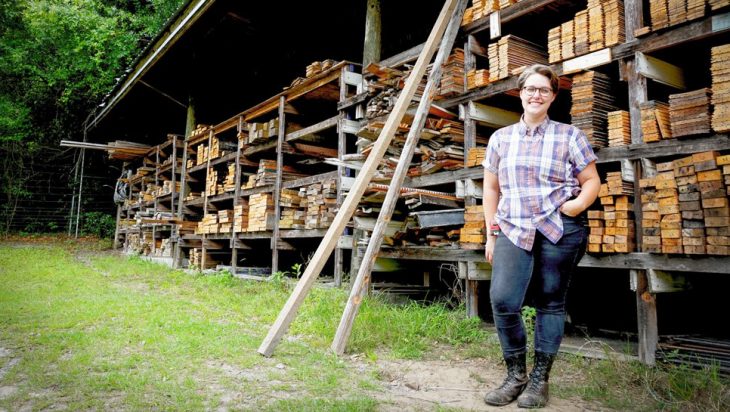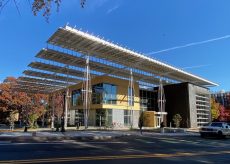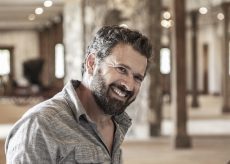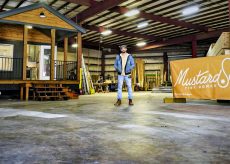Reclaiming History, One Board at a Time

In Savannah, Georgia, a promising local nonprofit branded as Re:Purpose Savannah, and comprised of an all female team, is turning the male dominated industry of demolition upside down through deconstruction– the process of taking a structure apart piece by piece, with the goal for preserving materials for reuse.
In a city like Savannah, with a rich architectural history dating back to pre-civil war days, this material preservation not only protects the stories and local heritage of past eras from a fate destined for landfills, but these materials and their inherent properties, characteristics, and embodied energy, are irreplaceable. Antique heart pine, for example, was produced from the longleaf pine, a tree that was once the dominant species in the southeast United States, but is now endangered. However, while very little of the old growth forests where these trees are able to mature to the 100-150 years they require before heartwood begins to form, the longevity of this material’s properties, including it’s extreme strength, hardness, and beautiful golden-red color, means it can still serve many uses in both building applications and crafts. It just needs a little polishing… or rather… sanding or planing.
All that being said, these ladies, led by the energetic, unwavering, and down-to-earth Executive Director, Mae Bowley, are not just challenging social norms, they are inspiring a whole new DIY and craft movement in the Savannah area, preserving the local history, strengthening the community’s sense of place, and creating healthier environments, from individual neighborhoods to the overall ecosystem.
Inspired by years of following this story, PGH reached out to Bowley to see if she’d be interested in speaking about the ins and outs of this movement, and if she’d be comfortable meeting at the Re:Purpose Savannah lumber yard, or if she’d just prefer to schedule something remotely. However, with much of the country, and even the world, being in lockdown at the time of this interview, Bowley expressed that since everyone is stuck at home (and, of course, having already binged through the entire Tiger King docuserieson Netflix), DIY and craft projects are on a lot of people’s minds, meaning sales are booming and she’s as busy as ever.
– Demolition vs. Deconstruction –
PGH: The demolition of buildings at the end of their life has been the default for a long time, but cities across the country are seeing a huge trend in adaptive reuse. Where does deconstruction fall on this scale? Are there other cities/organizations doing this?
MB: Well, adaptive reuse is an amazing way to leave a building in place. Ideally, it prevents an entire building from being taken down, but that does not preclude the involvement of a deconstruction operation. Most adaptive reuse projects do involve some aspect of major renovation and loss of material. Deconstruction crews can do partial demolition on these buildings, still salvage all of the good materials, and in most cases, flow those materials right back into the adaptive reuse projects – which you see a lot in really forward thinking projects and communities.

The east coast is a little late to the game here, especially the southeast coast. I don’t know if we can say it all started there, but in terms of policy, Portland was the first city in the nation to have official legal requirements for deconstruction on historic buildings. Since then, we’ve seen a lot of movement nationwide. More cities are requiring demolition to at least recycle, as opposed to just landfill, so that’s a step in the right direction, and then there are also cities we’re starting to see follow the arc of Portland and put in place policy to try to protect historic buildings.
There’s a lot of spots on the spectrum, and a lot of business happening. Probably the fastest growing aspect of this industry is what we like to call ‘soft strip’. A lot will call it deconstruction, but what they’re doing – what we call ‘soft strip’ – is going in and stripping out the really easy, low-hanging fruit before a demolition. What we do, though, when we deconstruct a building, we take it down to the lumber. We’re harvesting the structure, not the finishes. Generally speaking, by the time we get to a building, it’s usually so far gone and been picked through a hundred times. We’re not pulling out really nice cabinets that are great for resale. We’re going after the lumber, but it’s all part of a reuse economy. Those finishes are a great entry point for businesses that are looking to start low impact. It’s much easier to soft strip than it is to do full decon.
– Deconstruction and Public Policy –
PGH: Has Re:Purpose had to be involved with any policy changes or anything like that?
MB: It is part of our long-term mission as a nonprofit to begin to affect policy in the Southeast, particularly here in Savannah, but it is secondary to our immediate goal. We feel very strongly that it’s important to build the infrastructure and prove economic viability before imposing any kind of requirements or restrictions on industry. It wouldn’t be fair to ask everybody in Savannah to suddenly start deconstructing every home when no one here has ever done it before – or when the people who have done [deconstruction], have done it with different goals in mind. So we’re much more about the carrot approach than the stick approach. And you know, there are different strategies for different places, but we’ve worked with some partners in Atlanta, Life Cycle Building Center, and they’re looking at the same problem.
They’re a wonderful organization, and an excellent example of the soft strip model. They did a lot of work with the city of Atlanta. They hosted a lot of workshops and charrettes to try to assess the situation and decide what’s the best way to move deconstruction forward, which actually ended up reinforcing that it’s probably better in this climate to work more towards incentivizing, rather than towards policy.
Even for people who want incentives beyond just helping to save the planet and doing the right thing, and also preserving our precious treasured history that’s endangered and irreplaceable, there’s also huge financial incentives. You get a tax deduction for the donation of the materials on top of a competitive price for the same service. Really, the only struggle is scheduling, but it just requires a different way of thinking. Just a minor tweak of the project as a whole – the system and the pipeline of how it works – results in an enormous benefit for all parties involved.
– Tracking the History of Buildings and Materials –
PGH: How do you track the history of the buildings and materials?
MB: It’s something we talk and think a lot about. It’s funny, I think it resonates right now. We’re talking so much about contact tracing and the media with COVID-19. It’s not dissimilar. It’s hard to do, but it’s probably much easier to track a piece of lumber than an invisible virus. We do exhaustive research and documentation on the project before we take it down, and photo document everything so we always have records that we can refer back to.
We dig up everything we can find. All the city archives, all the chains of residence, and we love old Sanborn Fire Insurance Maps… If you’ve never looked at them, they’re incredible – era by era plans – every block of the city. You can see the details of the shapes of the houses, like whether it had a porch on it, or was it two stories or one story, or was it a masonry structure. They go all the way back into the 1800’s. They’re amazing.
So everything that we can find within our local archives on the property, we attach to our own architectural renderings, which are usually done by architectural drafting students through a partnership with the local community college.
Once it comes here – once it’s no longer a house – I have spent a lot of time thinking about ways to communicate this visually to people – but one of the ways is to just keep batches separate. We use these lovely grid bays here. This one is all Hattie house. You can see I write on every piece, ‘HH’. Hattie House, seven and a half feet long. This is Webb house, nine and a half. This is Mercer Cottage. Originally we were just doing it spatially, but once we started to really fill up, we realized that we needed to start labeling the actual pieces. So we did this with windows and doors and everything… Just write on it with a Sharpie. It’s such a simple solution. Really took me almost a year to figure out just writing on it with a Sharpie is probably our best way. You think the solutions need to be complicated for something as intense as inventory management, but it turns out, writing on it with a Sharpie just really gets the job done.

Also, with the numbers written on the end, obviously we don’t have to dig. Before it was like, ‘I need a six foot piece,’ and we had to pull every piece out of the bay to find one. It was a nightmare. And then also in terms of inventory, because of coronavirus, we really prioritized getting the materials online. It’s really impossible to sell things online if you don’t know how much you have of anything, so we had to quantify everything. These are all… These are the growing pains of any kind of lumber industry business.
– Cultural Awareness and Appreciation –
PGH: So the Anderson house was built in 18….
MB: 1874. That is without a doubt the finest wood we’ve ever had here at the property…
PGH: Does that mean some of that material was produced through slavery?
MB: Well, the bricks we know for sure were. Savannah Grays were all produced at the local Hermitage Plantation, and only for a very specific amount of time, which was definitely during the slave era because brick production was affordable with slave labor. After the emancipation of slaves, it was no longer an affordable or profitable business, and you no longer saw the local production of brick in Savannah.
So, all the handmade local Savannah bricks that we’ve had here actually all had fingerprints in them from the enslaved people who were making them, so we very much take that seriously. I am getting goosebumps right now talking about it, and I get goosebumps every time I see one. I have some in my trunk if you want to see. In some of these fingerprints, you can even see the ridges of the thumbprint.
PGH: What does that mean for the resale of these? Is it culturally insensitive… or maybe, immoral… to sell them? Should they not be used?
MB: Well… I do think it’s a complicated question. It definitely doesn’t DE-value them. I mean, these are heritage. Each is one-of-a-kind, and they all represent a very complex part of our history.
[ *Showing indentation in brick* ]
He’s right here. See that? Right here, it’s a big one. And if you look, if you can get your eyes right, you can see the ridges of the fingerprint. Wow. You see that?
So, yes, it does increase the value. We take that very seriously. We definitely don’t try to hide that history. We try to be very honest about it. In fact, I’ve been in communication through a couple of mutual contacts with a new museum opening up in Charleston, and they might take a few of our bricks with fingerprints for their exhibit.
I like that you’re asking this, though, because I feel like the best way to handle this is to have these conversations about it. I do think we need to challenge these notions. Like why aren’t these all in a museum? Why do I have to sell them for $2 a piece, which is a lot for a brick. I mean we’re definitely valuing them, and the community definitely values them, but are we valuing them for the right reasons? Honestly, I’ve given many of them away to people who’ve come here – people with roots in the local community – especially families of color who come out on tours and obviously feel an impact when looking at these.
But what you’re touching on is a big philosophical debate in the world of preservation – museum preservation versus use preservation. Is it a better way to honor the object by taking it out of its context? Like putting it in a glass box in a museum, or is it a better way to honor the history by having it do its intended use? I don’t claim to have an answer. There are only more questions, and I think that the best thing we can do is be healthy and have these conversations and talk about them. Let’s discuss as a country what it means to handle these things, which are definitely the product of enslaved people’s labor. How do we best honor that? It’s a great question. I definitely don’t think that everything going to the landfill is the best way to honor these materials. I think I’d rather see handmade bricks used in someone’s landscaping than rotting in the dump, personally. Maybe there’s an even better scenario. I mean, we can go to some really fun and exciting places with this. Like let’s imagine flowing these materials back into structures for elevating communities of color. Let’s get creative and think about ways that we can best use these materials.
– Preserving History and Challenging Industry –
PGH: Alright, so to commemorate 2020 marking the 100 year anniversary of women’s suffrage in the U.S., the NTHP (National Trust for Historic Preservation)has launched a campaignto share the stories of places connected to women who changed history. How does it feel being a woman who is not just preserving and telling the stories of history, but also leading an all female team in a very male dominated industry and gaining widespread community support for what you’re doing… even without the female empowerment aspect really being realized?
MB: You can’t see my face, audience, but I feel good. It’s an awesome time to be a woman in an industry. I’m going to get choked up…
I am standing on the shoulders of a lot of women that have struggled uphill against unbelievable challenges to try to gain a little territory in industries that they have been excluded from. And this is one of the biggest ones.
This is a huge amount of money and it’s circulating in an enormous industry, and enormous economy, and women have less than 10% of that…. So we’re very proud, and very grateful, also, to be doing this at a time when it is easier for us… Like there’s grant funding for us now… The community, the whole country, is supporting women. The whole world is rising up for women in a way right now that just makes it freaking awesome and makes us able to do more with every bit of effort that we put into it.
So I’ll actually take this moment to tell you guys, we just got another grant which came from the AAUW, which is the American Association of University Women. It’s an organization that’s been around since the 1800’s, supporting women and girls, and especially in particularly male dominated industries. They just gave us $10,000 to continue developing curriculum, to get really official and safe, and to provide formal job training for women, specifically in construction… And, of course, I’m really looking forward to growing leadership roles and expanding the field of deconstruction as an agent.
PGH: How… How did the all-female aspect of it develop? This wasn’t a formal thing before, right?
MB: It actually happened by accident. There’s a reason we didn’t roll it in a big announcement that the company is now focusing on women and we’re doing women’s issues and stuff like that because it didn’t happen that way. It was very organic. So I’m obviously me and I am obviously a huge feminist. I work hard for women and I love helping support women who feel in some way excluded from contributing to the world in the ways that they want to. That’s really close to my heart. But when I took over this organization, I had no intention of focusing there.
I mean we knew we wanted to do workforce development and job training, but we hadn’t decided to focus specifically on women. It was an organic result of the fact that I think just me being visible on the Instagram accountand in social media as a woman doing this, women started coming out of the woodwork and contacting us. I didn’t do outreach at all. It made me feel really awesome and special because I didn’t… I mean, you don’t realize what an impact you’re having just by being a woman doing.
So, to women out there who are doing, just keep doing by just doing it, and by letting other people see you doing it, you are having an impact on people’s lives. Maybe you don’t know that or feel that, and I didn’t know that or feel that until like it started flowing in.
PGH: Was this a sudden epiphany, or kind of a slow realization?
MB: It was a bit of a slow realization. I would say there was definitely a moment when I realized this is a thing that we’re going to do, but it took a little while for me to make that decision. And it was also partially because I noticed a phenomenon.
We work with a lot of volunteers and I noticed this phenomenon in mixed gender volunteer situations, where often a lot of the dudes were like taking tools out of the girl’s hands because they weren’t doing it right the first time, or they didn’t know how to do it and there wasn’t a culture of teaching, but more of a culture of ‘I can do this faster than you. You’re wasting time. We can be more productive if those of us who already know how to do it just continue to do it’, which is very antithetical to our whole premise here. Over time, we did start to realize that there is a different culture of learning when you’re just a bunch of women together. When there isn’t a male voice, or a male gaze, or a male opinion, or even the most nontoxic, lovely, harmless man in the world, who can’t help the fact that he just is one… and that changes the dynamic when you’re in a group of women.
Of course, we still interact with men an enormous amount. Of course, we’re in a place spaced close to men. Most of our clients are men. A lot of my business partners are men. You’re a man. Our board has a lot of men on it. We don’t… we don’t mean anything. It’s just that there’s ample opportunity for men in this industry and there are very few, particularly in the South, for women, so we’re a little protective. We become a little protective of that space where we can learn safely together – where we can feel and grow our confidence. For a lot of women, the first step in being able to even play around in these spaces is just getting that confidence – getting over that deficit of confidence that’s been bred into us being told that this is not a space for us.
– Community Education and Placemaking –
PGH: Structural deconstruction, material preservation, historical and cultural research and storytelling, custom woodworking and hand-made goods, wholesale lumber supply, and most recently, apprenticeships and a studio for creative small business incubators included with a makerspace. What’s next? Is there anything left?
MB: Oh, geez. Do we need more? What’s next is continuing to get better organized down here… Organization, curriculum, and developing this place as more of a community space. We were supposed to start doing workshops this summer, but of course all of that’s on hold because of the virus, but ideally there is also a community education component. We’re working with Savannah State, but maybe we’ll have to wait until next year. People can look forward to that. In the meantime, we can just keep getting organized, prioritizing our online inventory,and encouraging this place as a space for artistic expressionfor the Savannah community, and as a beautiful marshfront park for community members to come and explore. We host yoga out here sometimes, we’ve had a few Undergo Music and Arts Festivals, which I’m so excited to do again, and then we’re hopefully putting together a plan to build a trail that connects with the dairy, another beautiful, undeveloped marshfront property that almost borders this property and is home to more local businesses like Pegasus Riding Academy, Vertu Farms, Savannah Victory Gardens, and Toole Sculpture Works.






